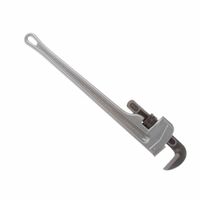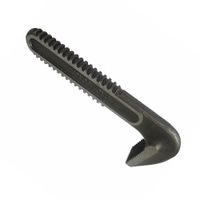Call +(254) 703 030 000 / 751 483 999 / 721 704 777
- Home
- Tools
- Hand Tools
- Wrenches
- Pipe Wrenches Replacement Parts
.....Read More
Frequently Asked Questions
What is a pipe wrench used for?
A pipe wrench is a tool specifically designed for gripping and turning pipes and pipe fittings. It is commonly used in plumbing to assemble or disassemble threaded pipes and fittings. The wrench features two serrated jaws: a fixed jaw and an adjustable jaw, which can be moved to accommodate different pipe sizes. The serrated teeth provide a strong grip on the pipe, allowing the user to apply significant torque without slipping.
The pipe wrench is particularly useful for working with round objects, such as pipes, because its design allows it to grip tightly as more force is applied. This makes it ideal for loosening or tightening pipes that are stuck or have been in place for a long time. The tool is often used in conjunction with other plumbing tools, such as pipe cutters and thread sealants, to ensure a secure and leak-free connection.
There are several types of pipe wrenches, including the straight pipe wrench, which is the most common and versatile; the offset pipe wrench, which is useful for working in tight spaces; and the end pipe wrench, designed for use on pipes close to walls or other obstructions. Additionally, compound leverage pipe wrenches provide extra leverage for stubborn pipes, while strap wrenches, which use a strap instead of serrated jaws, are used for pipes with delicate surfaces that could be damaged by traditional wrenches.
Overall, the pipe wrench is an essential tool for plumbers and anyone working with piping systems, providing the necessary grip and leverage to manipulate pipes effectively.
How do you use a pipe wrench properly?
To use a pipe wrench properly, follow these steps:
1. **Select the Right Size**: Choose a pipe wrench that matches the size of the pipe or fitting. Wrenches come in various sizes, typically ranging from 10 to 48 inches.
2. **Inspect the Wrench**: Ensure the wrench is in good condition. Check for worn or damaged teeth, as these can slip and damage the pipe.
3. **Adjust the Jaw**: Open the wrench by turning the knurled nut to adjust the jaw size. The top jaw should be slightly larger than the pipe diameter.
4. **Position the Wrench**: Place the pipe between the jaws. The hook jaw (top jaw) should be on the side you want to turn towards. Ensure the pipe is fully seated in the V-shaped opening.
5. **Align the Wrench**: The handle should be perpendicular to the pipe. This alignment ensures maximum grip and leverage.
6. **Tighten the Jaw**: Turn the knurled nut to tighten the jaw around the pipe. The teeth should bite into the pipe surface for a secure grip.
7. **Apply Force**: Hold the handle with both hands and apply force in the direction needed to tighten or loosen the pipe. Use smooth, steady pressure to avoid slipping.
8. **Reposition as Needed**: If the wrench slips or the pipe doesn’t move, reposition the wrench and adjust the jaw for a better grip.
9. **Release the Wrench**: Once the task is complete, turn the knurled nut to loosen the jaw and remove the wrench from the pipe.
10. **Maintenance**: After use, clean the wrench and check for any damage. Store it in a dry place to prevent rust.
By following these steps, you can effectively and safely use a pipe wrench for plumbing tasks.
What sizes do pipe wrenches come in?
Pipe wrenches come in a variety of sizes to accommodate different pipe diameters and applications. The sizes typically range from 6 inches to 60 inches in length.
1. **Small Pipe Wrenches (6 to 10 inches):** These are used for small pipes and tight spaces where larger wrenches cannot fit. They are ideal for household plumbing tasks.
2. **Medium Pipe Wrenches (12 to 18 inches):** These are versatile and commonly used for general plumbing work. They can handle a wide range of pipe sizes and are suitable for both residential and light commercial applications.
3. **Large Pipe Wrenches (24 to 36 inches):** These are used for larger pipes and more demanding tasks. They are often used in industrial settings or for heavy-duty plumbing work.
4. **Extra-Large Pipe Wrenches (48 to 60 inches):** These are designed for very large pipes and are typically used in industrial or construction settings. They provide the leverage needed to handle large-diameter pipes.
The size of the pipe wrench needed depends on the specific task and the diameter of the pipe being worked on. It's important to choose the right size to ensure a secure grip and effective torque application.
How do you maintain a pipe wrench?
To maintain a pipe wrench, follow these steps:
1. **Cleaning**: After each use, clean the wrench to remove dirt, grease, and debris. Use a wire brush to scrub the teeth and a cloth to wipe down the handle and other parts.
2. **Inspection**: Regularly inspect the wrench for any signs of wear or damage. Check the teeth for dullness or chipping, and ensure the handle is free from cracks.
3. **Lubrication**: Apply a light machine oil to the moving parts, especially the adjustment nut and the pivot points. This ensures smooth operation and prevents rust.
4. **Adjustment**: Ensure the jaw adjustment mechanism works smoothly. If it’s stiff, clean and lubricate it. Make sure the jaws open and close properly without excessive play.
5. **Storage**: Store the wrench in a dry place to prevent rust. Hang it on a pegboard or keep it in a toolbox to avoid moisture exposure.
6. **Rust Prevention**: If the wrench is exposed to moisture, dry it immediately and apply a rust inhibitor or a light coat of oil to protect the metal surfaces.
7. **Teeth Maintenance**: Keep the teeth sharp for a better grip. If they become dull, consider replacing the jaw or the entire wrench if necessary.
8. **Handle Care**: If the handle is wooden, occasionally apply linseed oil to prevent drying and cracking. For metal handles, ensure they are free from rust and damage.
9. **Usage**: Use the wrench correctly to avoid unnecessary strain. Do not use it as a hammer or for tasks it’s not designed for, as this can damage the tool.
By following these steps, you can extend the life of your pipe wrench and ensure it remains effective for future use.
What are the parts of a pipe wrench?
A pipe wrench consists of several key parts:
1. **Handle**: The long, sturdy part of the wrench that provides leverage. It is typically made of cast iron or aluminum for strength and durability.
2. **Jaw**: The wrench has two jaws - a fixed jaw and an adjustable jaw. The fixed jaw is attached to the handle, while the adjustable jaw moves to accommodate different pipe sizes.
3. **Hook Jaw**: This is the adjustable jaw that moves up and down the shank. It has serrated teeth to grip the pipe securely.
4. **Heel Jaw**: The fixed jaw, also with serrated teeth, works in conjunction with the hook jaw to grip the pipe.
5. **Nut**: A knurled adjustment nut located on the shank allows the user to adjust the position of the hook jaw, thereby changing the size of the opening to fit different pipes.
6. **Spring Assembly**: This component helps maintain the position of the hook jaw and provides tension to keep the jaw in place during use.
7. **Pin**: A pin or rivet holds the hook jaw and spring assembly together, allowing the jaw to pivot and adjust.
8. **Shank**: The part of the wrench that connects the handle to the jaws. It houses the adjustment nut and provides a track for the hook jaw to move along.
These components work together to provide a secure grip on pipes, allowing for effective turning and manipulation during plumbing tasks.
How do you replace the jaws on a pipe wrench?
1. **Gather Tools and Materials**: You will need a replacement jaw set specific to your pipe wrench model, a screwdriver or Allen wrench (depending on the fastener type), and possibly a wrench or pliers.
2. **Secure the Wrench**: Place the pipe wrench in a vice or on a stable surface to prevent movement during the replacement process.
3. **Remove the Old Jaws**:
- **Upper Jaw**: Locate the fastener (screw or bolt) holding the upper jaw in place. Use the appropriate tool (screwdriver or Allen wrench) to remove it. Slide the upper jaw out of its slot.
- **Lower Jaw**: The lower jaw is typically part of the adjustable nut assembly. Turn the adjusting nut to its maximum open position to release the lower jaw. If necessary, use a wrench or pliers to assist in removing it.
4. **Install the New Jaws**:
- **Upper Jaw**: Slide the new upper jaw into the slot. Align it properly and secure it with the fastener. Ensure it is tightened firmly but not overly tight to avoid stripping the threads.
- **Lower Jaw**: Insert the new lower jaw into the adjustable nut assembly. Turn the adjusting nut to secure the jaw in place. Ensure it moves smoothly and adjusts properly.
5. **Test the Wrench**: Open and close the wrench to ensure the new jaws are functioning correctly. Check for any misalignment or loose parts.
6. **Final Adjustments**: If necessary, make minor adjustments to ensure the jaws grip securely and the wrench operates smoothly.
7. **Clean Up**: Wipe down the wrench to remove any debris or oil from the replacement process. Store your tools properly.
What is the difference between a pipe wrench and a monkey wrench?
A pipe wrench and a monkey wrench are both types of adjustable wrenches, but they are designed for different purposes and have distinct features.
A pipe wrench is specifically designed for gripping and turning pipes and other rounded objects. It has serrated jaws that provide a strong grip on cylindrical surfaces. The top jaw is adjustable and can be moved closer or further from the fixed lower jaw using a knurled nut. The jaws are angled, allowing the wrench to bite into the pipe as pressure is applied, which prevents slipping. Pipe wrenches are typically made of heavy-duty materials to withstand the torque required for plumbing tasks.
In contrast, a monkey wrench is designed for flat-sided objects like nuts and bolts. It has smooth, flat jaws that are parallel to each other, making it suitable for gripping flat surfaces without damaging them. The monkey wrench also features an adjustable jaw, which is moved by a screw mechanism to fit various sizes of fasteners. Unlike the pipe wrench, the monkey wrench does not have serrated jaws, making it less effective for gripping rounded objects.
In summary, the primary difference lies in their design and intended use: pipe wrenches are for pipes and rounded objects with serrated jaws for a strong grip, while monkey wrenches are for flat-sided fasteners with smooth jaws to avoid surface damage.

